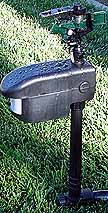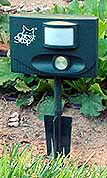

CAT WARS! This page reports how well different cat repellents work to keep cats out of a yard.
(Click on main site to browse 70 other topics ranging from exotic kaleidoscope designs to the strange world of lucid dreaming.)
I
like cats. I think they are a better choice than dogs as domestic
animals. I have two cats of my own. I say this so that no one who
visits this pages thinks that I hate these noble animals. However, I
have a deep distaste for people who let their cats, or dogs for that
matter, run loose enabling them to relieve themselves on my lawn. I'm
sure that anyone who has stepped in someone else's pet's leaving will
agree that it is a disgusting and irresponsible thing for one
neighbor to do to another.
Early in 2004 a local cat decided to use my backyard as his personal bathroom. Every morning I would find he'd once again soiled my yard. I confess that after spending weeks cleaning up after someone else's mess I was tempted to resort to drastic measures. Thoughts of trapping the offending animal and turning it into the local pound or spraying it with skunk scent and setting it free to return home were two of my favorite fantasies. But, I reasoned that such acts would bring me down to the level of the person who was letting the cat loose so I resisted those tempting retributions and looked for a more benign solution.
The first step when entering into a war of any kind is to determine the enemy. After many hours of fruitless spying, I decided I needed a technological advantage to defeat my enemy's stealthiness so I rigged up a motion sensing alarm. Shortly after setting it in motion I was alerted to an intruder and took this picture:

The Enemy
It's an attractive animal and if it had more agreeable habits, like messing in his own back yard, I'm sure we could become friends. But this is war and in such endeavors friendship has no place.
The battle begins:
Petco stores sell a product called REPEL, which is a citrus smelling granular product designed to repel dogs and cats because it has an odor they dislike. It costs $11 for 2 pounds and is enough to treat 200 square feet. This presents a problem because it would cost $165 to treat my 3,000 square foot back yard. I purchased a single 2 pound container and spread it over my yard. Although this was a much lower dosage than directed, it still worked. For three days the cat did not soil the yard. Then I had to water and all the repellent was washed away. The next day I discovered the cat had returned.
Next I tried SHAKE AWAY for domestic cats. This product is available at Armstrong Nursery Centers and uses an mixture of dried coyote and fox urine to fool cats into running away under the impression that predators are near. It worked as well as REPEL but cost twice as much and had an unpleasant odor. Besides, I wasn't sure if I liked the idea of my grandchildren rolling around on grass that had been covered with animal urine. It also lost it's effectiveness after watering.
An Internet search for cat repellents provided the information that cats dislike citrus odors and cayenne. I tested the first by mixing one quart of pure lemon juice with one gallon of water and spraying the entire backyard with this mixture. It didn't work. It may be that to be effective I'd have to use 100 percent pure juice. That runs the risk of burning the grass and would be expensive. The cayenne powder worked for several days and when purchased in bulk from a restaurant supply store like Smart and Final, was the cheapest of the techniques tried so far. However, like all the other applied products, it lost effectiveness every time I watered the lawn and would have to be reapplied. For someone who waters everyday this could get to be an expensive and time consuming option. Besides, there's no telling what putting that much cayenne, or any of the other products, on a lawn might do to the lawn over the long run. Something better had to be available.
There was.
I
found the solution in an electro-mechanical product called the Scarecrow
(http://www.scarecrowinfo.com).
This is a battery powered motion sensor used to control a water
sprinkler. When a cat comes within 40 feet of the detector it turns
on the sprinkler for a 4 second burst, enough for the impulse-type
sprinkler head to rotate 180 degrees. The combination of sound,
sudden motion, and falling water startles the cat and chases it away
in the most humane manner possible.

The unit is easy to set up and is 100 percent effective at scaring cats away. The only down side to this product is that it costs $59 for a single unit. Depending on the size and shape of your yard several may be required. In actual use I found that a nine volt battery lasts three to four weeks. However, this depends on the sensitivity setting. At the highest setting on a windy day the breezes will constantly tripper the device and reduce battery life. At the maximum sensitivity the device triggers on a sixty foot radius. I found reducing it to two-thirds of maximum stops it from going off from wind yet turns it on if anything walks into the area reached by the sprinkler.
Here's a similar device called Cat Stop:

It has a motion sensor that triggers an ultrasonic noise that scares cats away. I used one of these to cover an area not protected by the sprinkler and it's been 100 percent effective.
It only costs 49.00 dollars and one nine-volt radio battery is supposed to power it for eight months. It's convenient because there are no hoses to fight but it only has a twenty foot working distance over a 45 degree pie-shaped area. Although it seems to work outside where cats are on edge and easily scared away, I discovered it doesn't do anything to house cats when used inside their house. I talked to a representative about this and he explained than under those conditions a house cat is on his own turf and unlikely to be frightened. Also, most people who test the device inside will be standing near it to observe the results. This is another signal to the cat that because someone is present nothing bad is going to happen.
Information
about Cat Stop is also available from http://www.scarecrowinfo.com
A nine volt battery only lasts one week in the units I have. This is much less than the advertised 9 months.
After confirming that both devices work, I set up three of the ultrasonic repellers on one side of my yard and two of the water jet repellers on the other to see which is more effective at keeping cats out of my yard. After a week of use both have been 100 percent effective.
So, I am happy to announce that the CAT WARS are officially over and I was victorious. My only misgiving is that I was forced to spend hundreds of dollars to protect myself from someone letting their pet run wild.
UPDATE!!! One year after writing this article a cat began urinating on one small area of my backyard, killing the lawn in many spots. I placed two two of the ultrasonic Cat Stop units to guard the area and within two weeks the grass had completely grown back, indicating that the Cat Stops had succeeded in getting rid of the cat.
ANOTHER UPDATE!!! While these devices worked for me, constantly changing their batteries was tiresome and expensive. Additionally, the water unit causes mildew problems on most of the plants in flower beds. I found a simpler, cheaper and more reliable deterrent in the form of plastic fencing.

Available
in Lowes hardware stores for $30 for a 4-foot wide by 50-foot long
roll, it can be easily cut with scissors into whatever shape needed
to protect planter beds. The 2 x 2 inch holes allow most plants to
grow unhindered. Larger plants can be accommodated by cutting out a
slightly larger opening. Cats don't relieve themselves where they
can't dig, so this simple barrier stops them cold without having to
use batteries or water sprays. Cutting the roll into 4-foot wide
section 34-inches long yields easily handled sections that will cover
a 65-foot long bed that's 3-feet wide. These sections stack and store
with little effort. Because they are mostly open, there's not enough
surface area for wind to catch on and move them around. If winds are
high enough to shift them, a few weights or garden pins will secure them.
(Click on main site to browse 70 other topics ranging from exotic kaleidoscope designs to the strange world of lucid dreaming.)